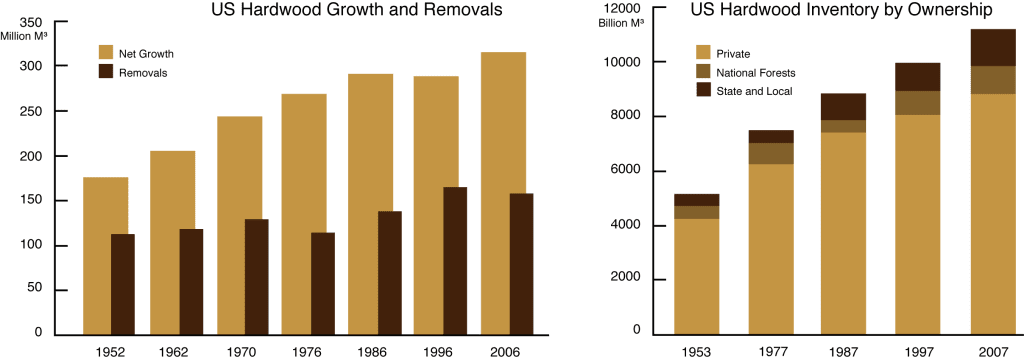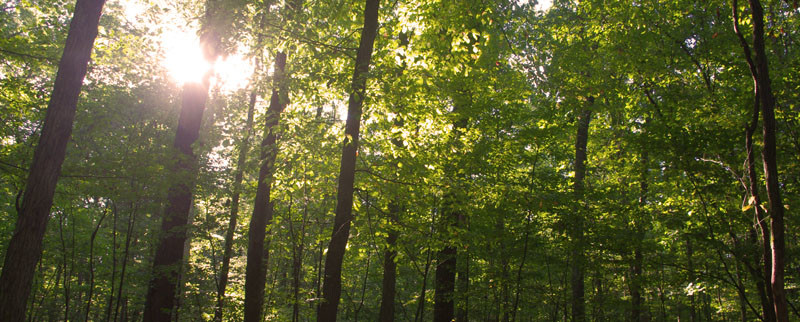The Sustainable Future of North America’s Hardwood Forests
Given the severe deforestation in South America, one might assume North America’s hardwood forests are similarly harvested unsustainably. However, this is not the case. However, there are many characteristics of the US Hardwood Forest that make it ideal at providing high-value lumber products. It does so in a sustainable fashion. Additionally, it sequesters carbon at the same time.
While environmentalists hold firm stances on logging and forest management, the facts strongly support the North American forest-products industry’s sustainability.
Hardwood trees are sustainable, biodegradable and renewable.
The North American Forest Continues Growing
Hardwood Timber in North America is highly-sustainable.
The following graphs illustrate that timber volume has increased substantially since the earliest data collection What’s better, is that net growth, which equals estimated volume less the amount harvested, has steadily increased over the last 50 to 60 years.

Sustainability Of U.S. Hardwood Forests
U.S. hardwood forests are abundant, growing in both land area and volume, and are highly sustainable. This is partly due to the relatively small average holding of timber, with 80% of timber land in private hands. With about 10 million landowners, timber harvests generally occur once per landowner’s lifetime. Each year, hardwood volume increases by about 630 million board feet, even after accounting for harvests, fires, storms, and insect losses. This makes North American hardwood forests not only abundant but also sustainable, providing a clear environmental advantage over processed materials like plastic, concrete, and steel.
Clean And Renewable Timber (Advantages of American hardwood)
Hardwood timber is renewable, as trees are replanted at a rate of six for every one harvested. This leads to around 2.6 million new acres of trees planted each year. Unlike softwood industries, hardwood forestry doesn’t need strict oversight or constant planting. Harvesting focuses on mature trees that are best at absorbing carbon, causing little harm to the forest floor and canopy. This method boosts air quality by releasing oxygen and reducing carbon dioxide. Turning wood into building materials locks in carbon for the long term. U.S. forests absorb greenhouse gases equal to the emissions from about 139 million cars.
Hardwood: A Sustainable Building Material
Wood is a natural and renewable material that offers major environmental benefits compared to concrete and steel. It generates less waste, releases fewer greenhouse gases, causes less pollution, and uses fewer resources. Wood also costs less to produce and dispose of, making it a more environmentally friendly option for construction. U.S. hardwood forests are managed in ways that ensure their long-term health, providing a reliable source of sustainable building materials. Thanks to the combined efforts of the forest industry and government agencies, it’s clear that U.S. hardwood forests will remain a sustainable resource for future generations.


Comments 1
Unfortunately I only have one red oak and seven hickory the oak is every bit of 34″ across and 75′ to 80′ to its first limb … The hickory have bout 12- 16 inches across each crocheted bout 18′ to 30′ from ground resulting in 2 state trunks. I tried estamating the board ft of the oak going from the chart provided on ur site has every bit of 1590′ is that fair to say? Then the hickory just may be to small compared to the oak. I don’t have much knowledge of value and volume. But i would be more then willing to send photos via smart phone or via email. Please contact me about the timber. The trees have been here long before the house and the house was built mid 1930 there is no metal or foreign materials in the tree. I would rather receive a txt the email 3307347395 thank you for the insight of all of whats behind foresty